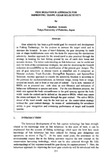Fish Behaviour Approach for Improving Trawl Gear Selectivity
Abstract
Gear selectivity has been a gold-medal goal for research and development in Fishing Technology, for the purpose to increase the target catch and to decrease the bycatch. In case of trawl fisheries, the gear designing by mesh size or shape modifications were only the tools for improving the species/size selectivity. Another approach for the aimed trawl is also practical through the strategy in locating the best fishing ground by use of catch data bases and acoustic devices. The better understanding on fish behaviour can be useful not only for both of the conventional strategies, but also for developing the bycatch reduction devices(BRDs) as the modification of the present gear designs. The aim of gear selectivity in shrimp trawls is classified into 4 categories as Monster excluder, Trash Excluder, Shrimp/Fish Separator, and Species/Size Selection. Another approach to classify the selectivity function is according to the positions for exclusion/selection, as between warps, sweep lines or wings, around net mouth, and in front or rear part of codend. Up to now, varieties of BRDs are in practical use with ideas on size filtration and utilization of behaviour differences in species and sizes. For the size filtration purpose, the mesh size against the body circumference or the grid spacing against the body width inside the codend can be defined as the passive BRDs which may cause the stress and injury for escapees through the gear contact. The active BRDs ahead of the trawl mouth may be the best tool as the conservation strategy without the gear contact damage, by means of understanding for avoidance ability in gear recognition and swimming performance of target and bycatch species.
Citation
Arimoto, T. (1997). Fish behaviour approach for improving trawl gear selectivity. In Proceeding of the Regional Workshop on Responsible Fishing, Bangkok, Thailand, 24-27 June 1997 (pp. 251-265). Samut Prakarn, Thailand: Training Department, Southeast Asian Fisheries Development Center.

